Insta-Mold Earplugs
E.A.R. Inc.
$45–$60
www.earinc.com
800.525.2690
Many of my friends who ride long distances use earplugs to protect their hearing when they’re on the road. I didn’t consider using them until I developed tinnitus, a condition that results in the perception of sound—whining, buzzing, ringing, clicking, whooshing or any number of other noises—within the ear in the absence of any outside sound. More than one medical professional has advised me that tinnitus is an indication of permanent hearing damage, and that if I don’t take steps to protect my hearing, it can get much worse than it already is.
In recent years, I’ve tried various types of earplugs, all without much success. None of the foam earplugs, even the self-adjusting ones, stay positioned properly inside my ear, and as a result I lose them at an alarming rate. Silicone earplugs that can be molded to the inside of my ears fare only slightly better because, as with the foam ones, I can’t get them deep enough in my ear canal to stay put. Because of the imperfect fit of these store-bought earplugs, they really don’t do much to reduce noise. So when I saw the E.A.R. Inc. display in Sturgis, I figured I’d make one more attempt at getting a set of earplugs that fit well.
The Ear Inc. representative sat me down and peered into each ear, telling me that my ear canals were curved in such a way that traditional earplugs would never work for me. It was nice to get my suspicions confirmed, but what’s the solution? She recommended Insta-Mold earplugs that she would customize to fit my ears. After swabbing the inside of my ears with a cleaning lotion, she mixed a solution of medical-grade, hypoallergenic silicone, inserted it into a syringe and squirted the stuff into both ear canals to create the molds. She smoothed the outer face of each mold and left them in my ear for about 10 minutes, allowing each earplug to harden. After removing the Insta-Molds, she then placed a small, blue circular disk, the Identi-Tab, on the face of the left earplug so that I could distinguish the left from the right.
Upon removing the earplugs from my ears, she used a dremel to smooth the outer edges, mounted each Insta-Mold onto a toothpick and applied Insta-Seal Plus Silicone Koter for protection against dirt and debris. I was instructed to come back the next day because the earplugs take about 24 hours to fully harden. When I came back to pick them up, I was shown how to properly insert and remove the plugs (a quarter-turn back for insertion and a quarter-turn forward for removal).
I wore the Insta-Molds while still in Sturgis, and the fit was perfect. According to the product literature, when made correctly, the earplugs provide a “tissue to tissue” fit that follows the crevices and contour of the ear, allowing the wearer to use the earplugs in comfort for long periods of time. This nearly perfect fit also allows the Insta-Mold to achieve an EPA-adjusted Noise Reduction Rate of 29.8 dB, meaning a high level of hearing protection for the wearer. (The NRR is defined as the maximum number of decibels by which the hearing protector will reduce sound levels when worn.)
The National Institute for Occupational Safety and Health states that exposure to noise at 100 dB is safe for only 15 minutes, and that permanent hearing loss can occur with prolonged exposure at 85 dB or above. Although some of the sound tests for motorcycles are quite subjective, one study shows that the range can go from 74 dB at idle to 116 dB at highway speeds, so the nearly 30 dB NRR that the Insta-Molds provide can really help save your hearing.
The true test, though, was on my ride back from Sturgis—about 1,800 miles of high-speed Interstate. It took me a little while to get used to the noise reduction, but I soon realized that I could hear everything that’s important, like sirens and horns. At my first gas stop, I found that I could even carry on a conversation without taking the Insta-Molds out. The primary goal of these earplugs is to mask out wind noise, which causes just as much, if not more, damage to your hearing as engine, exhaust, or other sounds. At 30–40 mph, wind noise dominates, even when your bike has a windshield mounted. That wind noise prevents you from hearing other noises that you need to hear, such as sirens, voices, and the like. Due to the fatigue-fighting “selective hearing” properties the Insta-Molds provide, I’m able to spend longer amounts of time in the saddle.
Although E.A.R. Inc. makes a number of other hearing protection products such as the Musician’s Filtered Earplugs available for riders who listen to audio and the Acoustical Filtered Earplugs designed for hunters and shooters, I find that my Insta-Mold earplugs work much better at the shooting range than shooter’s ear muffs alone. You can find the E.A.R. Inc. display at many motorcycle rallies and events. Or, if you contact the company, you will be directed to the nearest provider. For best results, make sure that the person fitting them to your ears has been properly trained by E.A.R. Inc. The Insta-Molds come with a nifty plastic carrying case, and are easily cleaned with soap and water. The company states that modifications or replacements will be made during the first 30 days after your purchase.



















